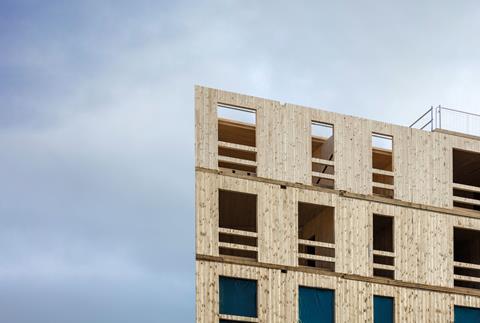After the fire at Grenfell Tower, it was inevitable that the materials used to construct high-rise buildings were going to come under scrutiny. Thomas Lane looks at the government’s proposals, published last week, to see what they might mean for specifiers and manufacturers

Last week the government published its consultation into a ban on combustible cladding materials. The proposals are uncompromising: it suggests a ban on all combustible materials in the walls of buildings over 18m high. The government also wants to see an end to full-scale testing of cladding systems as an alternative means of compliance. This means the end of desktop studies, as these were meant to be based on the results from these tests.
These proposals are hardly a surprise, given the way fire spread rapidly up the exterior of the Grenfell Tower. Since then, there has been pressure for a ban on combustible cladding from relatives of the victims of the tragedy, as well as the media and some in the industry. But what are the implications of the proposals?
The consultation says that buildings over 18m high should not include combustible materials in the “complete wall assembly, including the inner leaf, insulation and the facade”. This ban includes the areas of the building below the 18m cut-off too. The consultation acknowledges that the external wall in a high-rise building is usually separate from the wall assembly, but does not explicitly say the ban excludes the structure. Some interpret this as excluding the structure from the ban, while others take a different view.
It could potentially mean a complete collapse of CLT in this country – we would go from a world leader to a backwater
Anthony Thistleton, Waugh Thistleton
Combustible paints, wallpaper, laminated glass and seals would still be permitted. “There are certain materials that aren’t available in non-combustible versions at the moment, which include vapour membranes, gaskets and seals,” explains Andrew Mellor, a partner at PRP Architects. “If there was a blanket ban, rainscreen cladding systems would disappear until the manufacturers developed new products.”
The ban would also apply to balconies and brises-soleil attached to facades. It would have a limited impact on the choice of external cladding panels, as there are plenty of compliant materials available. Cladding components such as sheathing boards are already available in non-combustible versions. Masonry construction would be unaffected.
There are potentially two big losers from the proposed ban on combustible materials: foamed plastic insulation and cross-laminated timber construction. Foamed plastic is popular because of its high performance and light weight. Non-combustible mineral wool needs to be 80% thicker for the same thermal performance and is much heavier. It requires a much more substantial cladding support system and thicker window reveals, which reduces the amount of light reaching inside apartments. This comes at a cost. “On cramped sites, this will result in loss of floor area, with potential significant impacts on viability,” warns James Knight, the partner in charge of residential at Arcadis.
Moreover, Knight has studied the government’s cost assessment of the change to non-combustible materials. “We think that the modelled assumptions around both cladding area and costs are optimistic,” he says. According to the consultation, a 15-storey building has a cladding area of 1,700/m2, pushing up the cost by £25,000 to £75,000. According to Arcadis, a 15-storey building has nearly double that cladding area, with a non-combustible rainscreen system costing substantially more – an extra £350,000 to £400,000. A switch to a masonry system would push the cost up by £850,000 to £900,000. Arcadis warns that the ban would limit supply and choice, with the result that prices would go up even more.
What’s in and what’s out
The propensity for materials to burn varies widely from those that burn rapidly and make a significant contribution to a fire, to those that do not burn at all. Between these two extremes are materials that burn slowly and do not make a significant contribution to a fire and those that will stop burning once a source of ignition is removed.
The consultation has proposed using the EN 13501 standard that tests for reaction to fire.
Part B of the Building Regulations, which covers fire, also references a British standard, BS 476, which can be used as an alternative to EN 13501. As these two standards measure performance differently, confusing specifiers, the government wants to drop references to BS 476.
The classifications in the EN 13501 standard range from A, which is non-combustible and includes materials such as brick, to E, materials that are flammable with a high contribution to a fire. The Reynobond PE cladding panels used on Grenfell Tower had a B rating, according to the BBA certificate, although the manufacturer’s own test data referenced in Barbara Lane’s expert report into the spread of fire at Grenfell gave it an E rating.
The consultation defines acceptable materials as those with an A1 or A2 rating. A1 materials are defined as making no contribution to a fire and A2 as making no significant contribution to a fire at any stage. A1 materials include brick, stone, and mineral wool insulation. A2 materials include plasterboard and fibre cement board. Reynobond panels are available with an A2 rating: these feature a mineral core.
Timber, foamed plastic insulation and high-pressure laminate cladding panels would not meet the consultation’s proposed classifications and would be banned on buildings over 18m.

The biggest losers
Unsurprisingly, foamed plastic insulation manufacturers are not happy. According to John Garbutt, Kingspan Insulation’s divisional marketing director, there is “no way” the company’s foamed plastic products could pass a test that met the consultation criteria because it is 100% organic. The test for non-combustibility, called EN 1716, involves heating the material
in an enclosed chamber and measuring how much additional heat is produced by the test sample. Garbutt says the phenolic insulation manufactured by Kingspan chars when exposed to a flame and goes out when this is taken away. “The test doesn’t tell you how quickly the sample burns or reacts to a fire.”
The full-scale test of a complete cladding system to BS 8414 was used by manufacturers such as Kingspan Insulation to demonstrate compliance with Part B, an option that would no longer be available. “Material testing can’t be a proxy for system performance,” Garbutt says. “There is a cavity in rainscreen cladding systems. You can’t do a material test that measures the impact of the width of that cavity on how the system performs.”
Waugh Thistleton Architects specialises in designing cross-laminated timber residential buildings. This includes Dalston Works, a 33m-high apartment block in London’s Hackney that was completed last year. Director Anthony Thistleton interprets the ban as applying to CLT construction and warns it could spell the end of a rapidly growing form of construction because the “sweet spot” for CLT is on buildings more than five storeys high. Below that height, other materials such as SIP panels make more financial sense. “Nothing in the wall from the inner to the outer surface can be combustible. We think it will preclude the use of CLT from being used above six storeys,” he says. “It could potentially mean a complete collapse of CLT in this country – we would go from a world leader to a backwater.”
Thistleton points to the benefits of CLT: it is lightweight, which means that less concrete is needed for the foundations; it has low embodied carbon content; and it enables a rapid construction process.
CLT is seen as offering better fire performance than traditional timber frame because of its relatively small surface area to volume ratio.

“We are confident CLT doesn’t offer any additional risk at height and fire doesn’t progress up a building in the same way as at Grenfell,” Thistleton says. Unfortunately, there is a paucity of CLT cladding system test data to back this up and only eight weeks until the consultation closes in August to find it. “We can demonstrate it is safe but we need to be given a chance to do it,” he says. Waugh Thistleton is co-ordinating a CLT-industry-wide response to the proposal.
Thistleton and others warn that a ban on combustible materials in cladding systems above 18m could shake confidence in lower-rise buildings. “The minute it is banned on buildings over 18m, it has an impact on lower-rise buildings too,” he says. PRP’s Mellor reckons this is already happening. “We are already seeing solicitors and mortgage providers asking questions about lower-rise buildings.” He adds that some clients were switching to non-combustible cladding systems for buildings still on the drawing board before the proposed ban was announced. This trend is likely to accelerate as the consultation proposes any building that has not started on site would be covered by the ban, even if the design had already been signed off by building control.
Mellor thinks the ban could also have ramifications for existing buildings, as the regular safety case reviews proposed by the Hackitt report for existing high-rise buildings will pick up combustible cladding materials. “This has major implications for viability, cost and the impact on the ability to sell,” he says.
Full system testing
Both Thistleton and Kingspan’s Garbutt believe the answer to the problem of fires in cladding systems is full system testing. Thistleton points out that the proposed ban is a prime example of prescriptive regulation, an approach Hackitt warned against in her report. He draws attention to her suggestion that the industry should, instead, be moving towards systems that are certified and tested. Garbutt says full-scale testing to BS 8414 is the only way to establish system performance. BS 8414 is intended to demonstrate that fires will not spread externally faster than inside the building. “You show me a building anywhere in the world where there has been an out-of-control cladding fire where the system has passed or would pass a BS 8414 test. I don’t think you will find one.”
Like Thistleton, Garbutt says the answers are in Hackitt’s final report. “The elephant in the room is that people don’t build things properly,” he says. “Hackitt was bang on: you can regulate such that we build everything out of steel and concrete, but people will still build things that don’t meet the regulations.” He concedes that Hackitt’s recommendations will take several years to implement and suggests one way to tackle poor build quality in the interim is to train up a crack force of building control officers to focus purely on high-rise residential buildings. Given the highly politicised nature of this debate, Thistleton and Garbutt are likely to be disappointed by the government’s final decision.



























1 Readers' comment